Recent progress with quantum-cascade lasers makes them attractive sources in the important 3- to 5-μm spectral range.
Dr. Quankui Yang, Christian Manz, Dr. Wolfgang Bronner, Dr. Klaus Köhler and Joachim Wagner, Fraunhofer Institute for Applied Solid State Physics
There exists a gap in the performance of semiconductor lasers in the 3- to 5-μm-wavelength range, a spectral range of particular interest for molecular spectroscopy as well as for applications such as directed infrared countermeasures. The 3- to 5-μm range is important not only because the characteristic absorption bands of, e.g., CO, N2O, HCl and CH2O, lie within this range, but also because there is an atmospheric transparent window in this range.
Because semiconductor lasers are compact and robust compared with other lasers, they are a favored candidate to address the 3- to 5-μm range. There are two approaches to fabricating semiconductor lasers operating at these wavelengths. The conventional method is based on two types of carriers — electrons and holes — making light-generating recombination across the semiconductor’s bandgap (an interband transition). Semiconductor lasers using this concept are called bipolar or diode lasers because both electrons and holes are involved in the lasing transition.
When an electron and hole combine across the bandgap, the energy of the resulting photon is the bandgap energy. Lasers with bandgap energies corresponding to visible or near-infrared photon energies are easily fabricated. However, at longer wavelengths — smaller bandgaps — parasitic nonradiative electronic processes such as Auger recombination degrade the laser’s performance. Other loss mechanisms, such as the intervalence band absorption, also become significant at long wavelengths for diode lasers in which holes are injected for light emission.
Quantum-cascade lasers,1 in contrast, are unipolar light sources based on only one type of carrier, usually electrons, making intersubband (intraband) transitions between confined energy levels within the conduction band. The term “cascade” comes from the fact that the confined energy levels are arranged in a cascading way, such that electrons undergoing lasing transitions travel from one stage to the next, just like water in a multiple-step water cascade. Therefore, one electron can emit sequentially up to n photons when n steps are present.
The emission wavelength of a quantum-cascade laser is determined not by the semiconductor bandgap but by the quantum confinement in the quantum wells created by the quantum-well material and the barrier material. Therefore, quantum-cascade lasers can cover a wide wavelength range using the same material system. Because only one type of carrier (electrons) is involved in the light-emitting transitions within the conduction band, the problem of Auger recombination and intervalence-related absorption does not exist for a quantum-cascade laser.
Even though quantum-cascade lasers fabricated from the same material system can cover a wide wavelength range, the shortest possible emission wavelength of a quantum-cascade laser ultimately is limited by the conduction-band offset between the barrier and quantum-well material (Figure 1). To obtain sufficient electron confinement for the initial laser state in the active region, a larger conduction band offset — i.e., a deeper quantum well — is required for the fabrication of short-wavelength (large energy separation between initial and final laser state) quantum-cascade lasers.
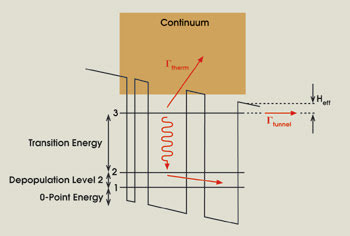
Figure 1. The maximum energy usable for the optical transition in the active region of a quantum-cascade laser is ultimately limited by the quantum-well depth. As a practical matter, the maximum optical transition energy is no more than 50 percent of the conduction band offset (because of the subtraction of the inevitable 0-point quantum-confinement energy) of the energy necessary for population inversion and of the energy necessary for the electron confinement to prevent leakage and thermoemission into the continuum states.
The most widely used material system for the fabrication of quantum-cascade lasers is the gallium indium arsenide (GaInAs) and aluminum indium arsenide (AlInAs) materials combination, grown lattice-matched on indium phosphide (InP) substrates.
This material system offers a conduction-band offset (quantum-well depth) of 0.51 eV. The inferior performance of GaInAs/AlInAs-based quantum-cascade lasers in the short-wavelength range (<5 μm) compared with those emitting at a longer wavelength (6 to 10 μm) is mainly because of the lack of sufficient confinement of electrons in the upper laser state.
To increase the conduction-band offset to achieve sufficient electron confinement for short-wavelength quantum-cascade lasers, one can balance the total strain by using compressively strained gallium indium arsenide layers for the quantum wells and tensile-strained aluminum indium arsenide layers for the barriers. By doing so, as well as adjusting the thickness of the individual layers, one can obtain a conduction-band offset of up to 0.74 eV, while keeping the total net strain of the whole structure close to zero.
Compared with the above-mentioned material system, the gallium indium arsenide and aluminum arsenide antimonide (GaInAs/AlAsSb) material system offers a combination of advantages for the fabrication of short-wavelength quantum-cascade lasers:2-4
• The lattice-matched GaInAs/AlAsSb heterostructures provide a conduction-band offset at the direct bandgap point of about 1.6 eV, large enough for the fabrication of short-wavelength quantum-cascade lasers in the 3- to 5-μm-wavelength range.
• The GaInAs/AlAsSb heterostructures can be grown lattice-matched on InP substrates.
• GaInAs/AlAsSb can be easily combined with the mature InP-waveguide technology because InP has a lower refractive index than that of GaInAs/AlAsSb. These three features make GaInAs/AlAsSb almost an ideal candidate for the fabrication of quantum-cascade lasers in the 3- to 5-μm atmospheric window.
Another material system offering high conduction-band offset is the indium arsenide and aluminum antimonide (InAs/AlSb) combination,5 grown either on GaSb substrates or on InAs substrates. This material combination offers a conduction-band offset up to 2.1 eV, which makes it also suitable for the fabrication of quantum-cascade lasers covering the 3- to 5-μm atmospheric window.
Fabrication procedure
A laser must be designed before it is fabricated, and that requires solving the Schrödinger equation to obtain the electronic wave functions and energy levels in quantum wells. Appropriately choosing the thickness of the quantum wells and of the barriers, the lifetime of the electrons can be tuned in the initial and final laser states. This allows fulfillment of the fundamental requirement of any laser: The lifetime in the initial laser state must be longer than that in the final laser state to achieve a population inversion. The energy separation also can be tuned by adjusting the thickness of the layers to reach the desired emission wavelength.
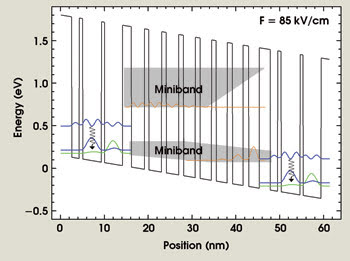
Figure 2. This diagram shows part of the conduction-band profile at the direct-bandgap point of two GaInAs/AlAsSb active regions connected by an injector. The squared moduli of the wave functions involved in the transition also are shown. The laser transition is indicated by wavy arrows, and the shaded areas indicate the miniband for electronic transportation.
As an example, Figure 2 shows a part of the conduction band profile of a GaInAs/AlAsSb quantum-cascade laser at the direct-bandgap point, displaying two active regions connected by an injection region. The “active region” is that portion of the layer sequence where light is generated and amplified by electrons making intersubband transitions, and the “injection region” is the portion connecting two active regions. The injection region supplies the electrons that will be injected into the active region.
The quantum-cascade laser shown in Figure 2 is based on GaInAs quantum wells and AlAsSb barriers grown lattice-matched on InP substrates. Part of the injection region is doped with silicon to a density of 2 × 1017 cm–3 to provide a sufficient electron concentration for electron transport via sequential tunneling. The design of this structure is based on an active region with transitions. As a consequence, the calculated lifetime is 2.61 ps for the initial laser state but only 0.48 ps for the final one, guaranteeing the population inversion between the states. Under the operation electric field, the energy separation between the initial laser state and the final laser state for the structure shown in Figure 2 is calculated to be 282 meV, which corresponds to an emission wavelength of 4.4 μm.
For fabrication, we sandwiched 25 periods of alternating active regions and injection regions between two GaInAs separate-confinement layers to form the core of a lateral waveguide. This structure was grown without interruption on a sulfur-doped InP (001) substrate in a solid-source, molecular-beam epitaxy system. After the molecular-beam epitaxy growth, we transferred the sample into a metallorganic vapor-phase epitaxy system to grow silicon-doped InP layers to serve as the upper waveguide cladding and contact layers. The lower waveguide cladding is formed by the InP substrate.
After we completed the metallorganic vapor-phase epitaxy growth, we processed the wafer by etching double trenches of approximately 5 μm width through the active region using chemically assisted ion-beam etching to define 7- to 34-μm-wide ridge waveguides. After depositing a silicon nitride isolation layer, we opened windows for top contact formation and evaporated the metal. We thinned the substrate down to around 110 μm and finally deposited a back-side metallization. Figure 3 shows a schematic diagram (left) and a scanning electron microscopy picture (right) of the cross section of a processed quantum-cascade laser ridge.
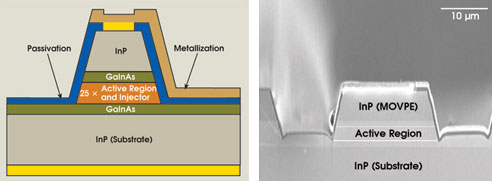
Figure 3. The schematic diagram (left) shows the material composition of the ridge-waveguide, quantum-cascade laser in the scanning-electron microscopy photograph on the right. MOVPE = mettalorganic vapor-phase epitaxy.
We cleaved the lasers into 1- to 3-mm-long bars, leaving the facets uncoated. After mounting the samples substrate side down onto gold-plated copper heat sinks and bonding the appropriate wires, we placed the lasers on a thermoelectric cooler for characterization. At this point, we drove the lasers with 100-ns current pulses at repetition rates between 1 and 5 kHz.
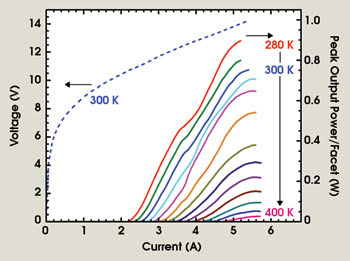
Figure 4. The optical output (right scale) as a function of injection current decreased rapidly as the heat sink temperature increased. Also shown is the voltage-current dependence at 300 K (left scale). These curves were obtained with an 18 μm × 2.8-mm laser operated in pulsed mode (100 ns, 1 kHz).
High-temperature pulsed mode
The lasers operate in pulsed mode at a wavelength of ~4.5 μm to at least 400 K (127 °C), the maximum temperature available in the present setup. Figure 4 shows typical light output versus injection current for a device with a ridge size of 18 μm × 2.8 mm, recorded at various heat-sink temperatures, as well as the voltage-current characteristic at 300 K. The maximum peak power per facet at 300 K (27 °C) is around 750 mW. At 400 K, the peak output power per facet is about 30 mW.
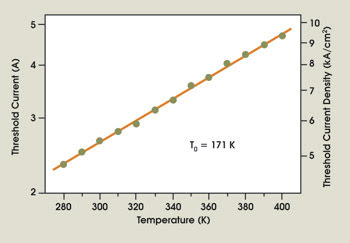
Figure 5. The threshold current (left scale) and threshold current density (right scale) of the GaInAs/AlAsSb quantum cascade laser are shown here as a function of heat sink temperature. These data were recorded for the same laser whose power characteristics are shown in Figure 4, and, as with the data in that figure, these were taken in pulsed mode (100 ns, 1 kHz). The solid line represents an exponential fit, according to the empirical relation Ith ~exp(T/T0 ), yielding a characteristic temperature T0 of 171 K.
The threshold current as a function of heat sink temperature is plotted in Figure 5. The exponential fit of the measured data yields a characteristic temperature of 171 K, describing how rapidly the threshold current increases with temperature: The higher it is, the slower the threshold current increases with temperature, and, consequently, the higher the maximum operating temperature of the laser. Thus, a high characteristic temperature is desirable in most cases. The characteristic temperature of 171 K for the present laser is much higher than that (about 100 K) for diode lasers emitting at similar wavelengths. Work is under way to optimize the growth conditions to further reduce the threshold current density of the lasers.
With a slightly modified design, we have realized short-wavelength (3.7 μm) GaInAs/AlGaAsSb quantum-cascade lasers with a high peak output power ( >8 W/facet at 77 K), in a device with a ridge size of 18 μm × 2.7 mm. To increase the single-facet output power as well as to reduce the threshold current density by lowering the mirror loss, we coated the back facets of selected devices for high reflectivity, yielding a facet reflectivity of 94 percent.
The intracavity loss for a 2.0-mm-long laser with the above high-reflectivity coating applied to one facet is calculated to 3.3 cm–1, compared with 4.7 cm–1 for a 2.7-mm-long uncoated laser.
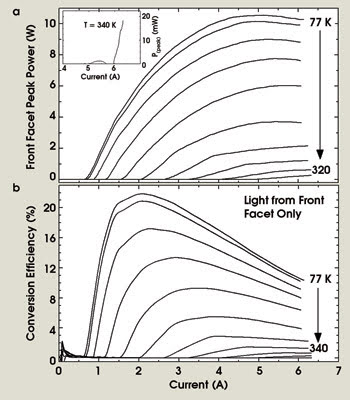
Figure 6. The light output emitted from the front facet of a high-reflectivity/uncoated GaInAs/AlAsSb quantum-cascade laser versus injection current is shown here for various heat sink temperatures. Laser emission is in the 3.65- to 3.8-μm wavelength range (see Figure 7). Ridge width and cavity length are 18 μm and 2.0 mm, respectively. The inset shows light output versus current at 340 K (a). These curves show the temperature-dependent, front-facet power efficiency as a function of injection current (b).
Figure 6 displays temperature-dependent light output versus injection current and power conversion efficiency versus current characteristics of an 18-μm × 2.0-mm high-reflectivity/uncoated GaInAs/AlGaAsSb quantum-cascade laser. Note that, for deriving the data shown in Figure 6, only light emitted from the front facet has been counted. The maximum pulsed-mode operation temperature of the laser is 340 K. The maximum peak power emitted (from the front facet only) is 10.5 W at 77 K, and still 19 mW at 340 K (inset of Figure 6a). At 77 K, the maximum power efficiency is 21.8 percent.
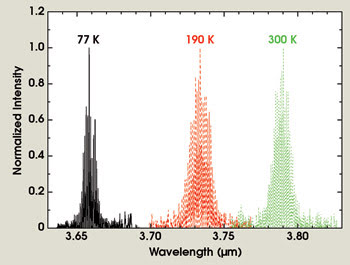
Figure 7. The normalized emission spectra of the GaInAs/AlAsSb quantum-cascade laser, whose power characteristics are displayed in Figure 6, are shown here at 77 K (black), 190 K (red) and 300 K (green).
Figure 7 shows the emission spectra of the quantum-cascade laser at heat sink temperatures of 77, 190 and 300 K. The emission wavelength is 3.65 μm at 77 K. At 190 and 300 K, the peak of the multimode spectra is 3.73 and 3.79 μm, respectively.
To summarize, we have demonstrated the potential of short-wavelength quantum-cascade lasers with the GaInAs/AlAsSb material system grown on InP substrates. Our future research will focus on optimizing the molecular-beam epitaxial growth of the structures so as to reduce the interface roughness and, thus, the inhomogeneous broadening of the gain spectrum.This could lead to a reduction in threshold current and to improved high-temperature and high-duty-cycle performance.
Acknowledgments
The authors would like to thank H. Menner for MOVPE overgrowth; L. Kirste for expert material characterization; K. Schäuble, B. Campillo-Lundbeck and K. Schwarz for technical assistance; Ch. Mann and F. Fuchs for valuable contributions to quantum cascade laser characterization; and G. Weimann for encouragement and continuous support. Financial support by the European Community under the project “ANSWER” is gratefully acknowledged.
Meet the authors
Quankui Yang is a research scientist at Fraunhofer Institute for Applied Solid State Physics in Freiburg, Germany; e-mail: [email protected].
Christian Manz is an engineer at Fraunhofer Institute for Applied Solid State Physics; e-mail: [email protected].
Wolfgang Bronner is a research scientist at Fraunhofer Institute for Applied Solid State Physics; e-mail: [email protected].
Klaus Köhler is a research group leader at Fraunhofer Institute for Applied Solid State Physics; e-mail: [email protected].
Joachim Wagner is a department head at Fraunhofer Institute for Applied Solid State Physics; e-mail: [email protected].
References
1. J. Faist et al (April 22, 1994). Quantum cascade laser. SCIENCE, pp. 553-556.
2. D.G. Revin et al (Nov. 1, 2004). InGaAs/AlAsSb quantum cascade lasers. APPL PHYS LETT, pp. 3992-3994.
3. Q. Yang et al (March 28, 2005). GaInAs/AlAsSb quantum-cascade lasers operating up to 400 K. APPL PHYS LETT, Vol. 86, 131107.
4. Q. Yang et al (March 20, 2006). Room-temperature short-wavelength (λ~3.7-3.9 μm) GaInAs/AlAsSb quantum-cascade lasers. APPL PHYS LETT, Vol. 88, 121127.
5. J. Devenson et al (Nov. 6, 2006). Very short wavelength (λ = 3.1 to 3.3 μm) quantum cascade lasers. APPL PHYS LETT, Vol. 89, 191115.